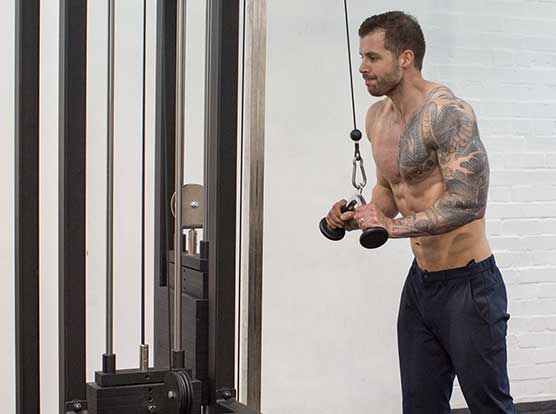Muscle building is a complex issue with rep ranges being one of the most highly discussed and disputed topics.
The basic rule of reps is:
Heavy weight and low reps for strength;
Moderate weight and moderate reps for increasing size;
Low weight and high reps for endurance.
It’s important to stress that there isn’t a one size fits all approach to reps. Â Individuals often have different goals: some may be looking to build strength while minimising weight gain, some may be hoping to improve muscle stamina, while others may just want to look good.
Also, everyone is different. Â Some people respond much better to low reps, others to high reps.
With that said, let’s look at the science of muscle building to bring you best plan for building muscle.
There are two main types of muscle growth or hypertrophy: contractile and non-contractile.
Contractile hypertrophy is the growth of sarcomeres, a component of muscles. Â In general, the more you have, the stronger you are. Â This kind of growth is also known as myofibrillar hypertrophy and sarcomeric hypertrophy.
Non-contractile hypertrophy, or sarcoplasmic hypertrophy, is the growth of non-functional parts of muscles. Â It is often thought of as being only of benefit to increase muscle size, but there is some evidence that an increase in sarcoplasm can lead to a growth in functional muscle growth.
With that in mind, let’s look at various rep ranges, and see what effect they have.
As heavy as you can go – 1-3 Reps
In this rep range, you are working on Neural Efficiency, as well as some contractile hypertrophy (strength gain).Â
An increase in Neural Efficiency increases the percentage of motor units that can be activated at any given time.Â
This has very little impact on size gains but can increase strength considerably. The strength increases will allow you to lift more weight for other rep ranges. But the risk to reward at this particular rep range is very high, as it is very easy to damage muscles and joints. Â
Due to the demands of this type of rep range you require a long rest period to recover. I would recommend 3-4 minutes.
The 1-3 rep range is a very effective way for increasing strength, but is best used only if you are an experienced lifter with very good technique.
Heavy 3-5 Reps
This rep range has been shown to lead to significant contractile hypertrophy, or improvements in muscle strength and size of sarcomeres[1].
The strength increases at this range will also allow you to lift more weight for other rep ranges. But just like the previous range, the risk of injury is moderately high[2].
The 3-5 rep range is likely the best option for increasing and maintaining strength.
Heavy weight – 5-10 Reps
In this rep range we have muscle growth from the addition and growth of muscle cells, or contractile hypertrophy, but also increase in sarcoplasm, or non-contractile hypertrophy. Â Therefore, this rep range will result in growth as well as strength gains.
Sarcoplasmic hypertrophy is not optimum for increase in strength, but it does increase muscle size.
This is therefore the ideal range if you are training to gain volume, such as a bodybuilder.
Moderate weight – 10-15 Reps
As you up the reps and drop the weight, you increase non-contractile hypertrophy and reduce contractile hypertrophy. Â On the flip side, muscle endurance improves in this range to a limited degree. Â This is the ideal range if you are looking to build muscle volume and endurance.
Light weight – more than 15 Reps
Strength gains are minimal compared to other rep ranges, but muscle endurance improves significantly, so this may be a useful range for some, such as rock climbers.
How many sets should I be doing?
How many sets you do depends on your goals and how much time you have.
With each successive set, you load the muscles further, allowing for greater adaptive gains. Â However, returns are diminishing as you get tired. Â The optimum balance between increased load and fatigue varies from person to person, but the total volume, or number of reps, you should aim for is 20-40: 20 for beginners, 40 for more experienced weight lifters.
So, for an example, if you are new to working out and are trying to gain volume in sets of 10 reps, you should consider starting out with 2 sets, resulting in a total of 20 reps. Â However, if you are moderately experienced and are trying to gain both strength and muscle size, so have settled on lifting weights in sets of 6 reps, you should be doing 5 sets to hit 30 reps in total.
This should only be considered a rough guide. Â The closer you are to your 1 rep maximum in your workout, the fewer total reps you should be doing. Â So if you are doing reps of 3 lifts at 90% of your 1RM, you might want to stick to 3 or 4 sets to avoid excessive fatigue. Â Conversely, if you’re training for endurance and doing sets of 15-20 reps, you might want to do at least a couple of sets to increase the volume.
If you find that your results plateau, but you are unable to increase the weight significantly, you should add an extra set to your workout to increase your load.
The importance of volume
All this being said, picking the right rep range can be counterproductive if it results in a large drop in volume.  By volume I mean the number of repetitions you do of an exercise during a workout. So 4 sets of 3 reps is the same volume as 2 sets of 6 reps.
Studies have shown that volume equivalent training with different rep numbers per set are just as effective[6].  So 4 sets of 10 reps is equivalent to 5 sets of 8 reps, as they both represent 40 reps in total.  You can use this to your advantage if you’re struggling to meet your reps. If you can’t quite manage 4 sets of 10 reps, try 5 sets of 8 and you should achieve the same results.
However, if you drop the number of reps because you increased the weight you’re lifting, you have increased the intensity of each rep. Â Therefore, you can reduce the volume while still maintaining a high adaptive pressure on your muscles.
The importance of variation
If you consistently train in the same rep and set range, and perform the same exercises, your results will likely hit a plateau. Â Variation is incredibly important as it forces your body to adapt.
Therefore, don’t stick with the same rep and set numbers for all your workouts. Â Try dropping the reps and increasing the weight, or try increasing the number of reps while dropping the number of sets. Â You can also vary your rest period between sets.
The importance of rest
You might think that resting between sets reduces the effect of your workout. Â However, studies have shown that longer inter-set rest period actually result in improved muscle gains.
This shows that resting is really important in your workouts, as it gives your muscles a chance to recover, and improves the quality of your reps in later sets, as you will be less fatigued.
In conclusion
The rep ranges you pick should be based on your goals. Â Low reps are great for muscle strength gains, high reps are better for muscle growth and stamina. Â It’s also important to increase your load as time goes on, to keep pushing your body to adapt.
However, rep ranges are not as important as session volume or intensity. Â There’s no point doing 3 rep sets if they’re easy.
For optimum progress use a gradually varied workout to maximise progress and prevent plateaus, and keep upping the weights as you get stronger to force your body to continue to adapt and get stronger.
Work hard, and you’ll see results.










